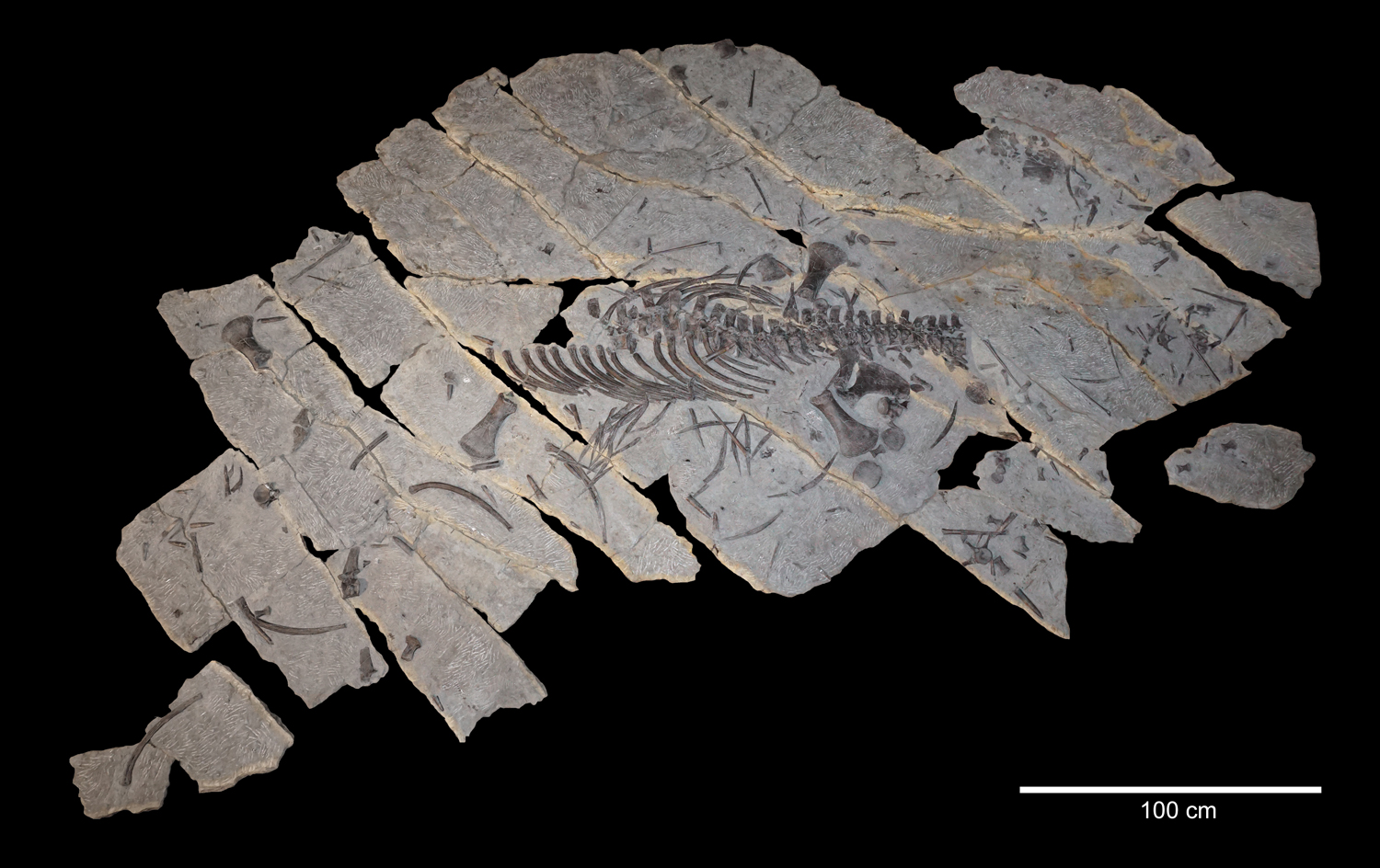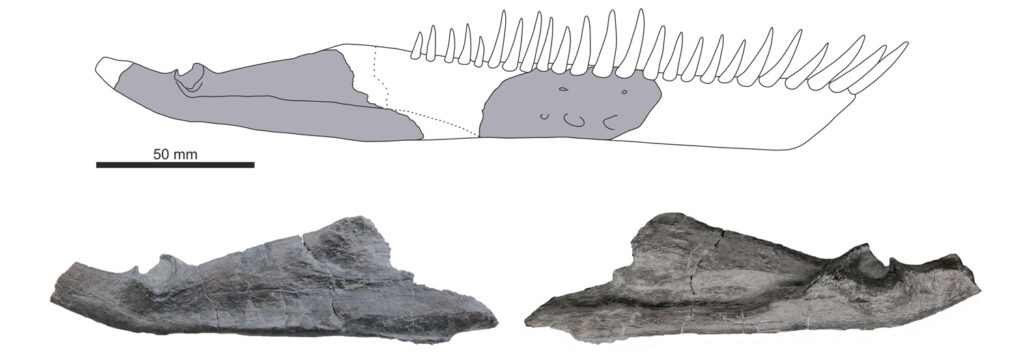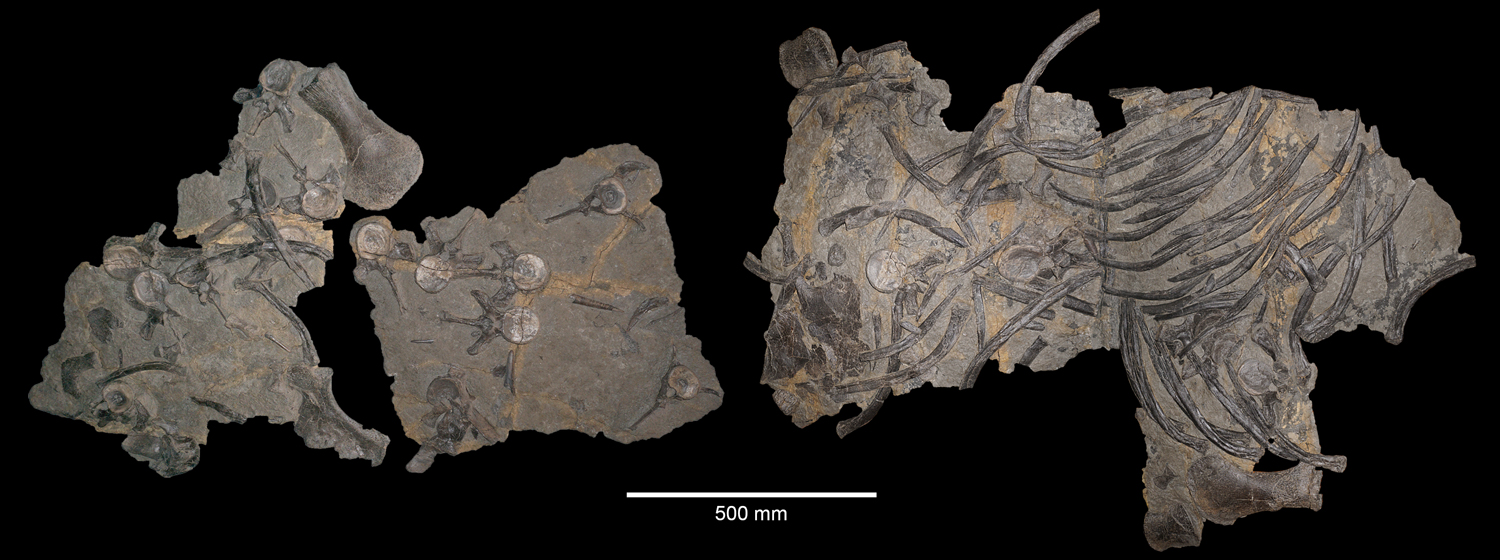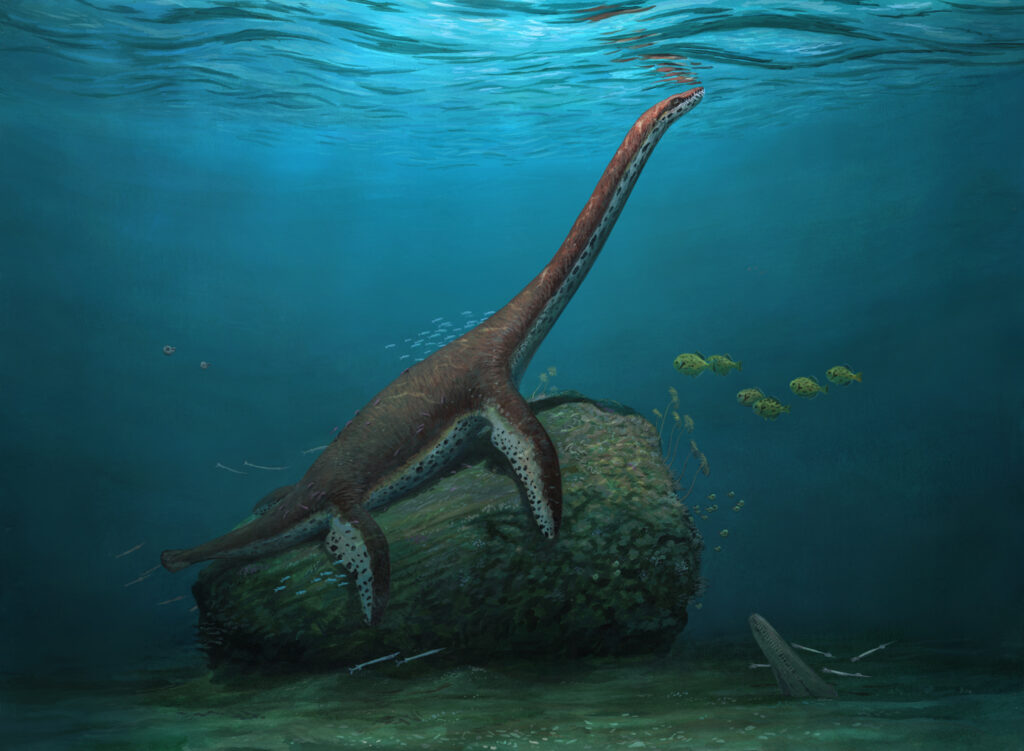Franconiasaurus brevispinus, a plesiosaur from the Lower Jurassic of Germany

In February 2024, our paper on Franconiasaurus brevispinus, a new plesiosaur from the Lower Jurassic found in a clay pit in Mistelgau, Germany, was published in the journal Frontiers Earth Sciences (Sachs et al. 2024). The generic name Franconiasaurus refers to the region of Franconia (Franken in German, a region in the northern part of Bavaria in southern Germany) where it was found. The species name brevispinus refers to the low neural spines in the posterior cervical, pectoral and dorsal vertebrae.
So far, we know the remains of two individuals of Franconiasaurus brevispinus. Both were discovered in the Mistelgau clay pit. They derive from the Grammoceras thouarsense ammonite zone of the upper Toarcium Jurensismergel Formation. Franconiasaurus is thus younger than the plesiosaurs from the Posidonia Shale found in the Holzmaden area, which are lower Toarcian in age. Both Franconiasaurus specimens, the holotype (BT 011224.00) and the referred specimen (BT 011241.00), have been discovered and excavated by a team of the Urweltmuseum Oberfranken in Bayreuth, under the direction of Stefan Eggmaier.
Which elements are known?
The holotype (BT 011224.00) is a fairly complete but only partially articulated skeleton. The bones of this specimen were scattered over an area of several metres. From the skull, only the posterior sections of both mandibular rami and a fragment of the middle section of the right mandibular ramus are known.

From the postcranium we know 24 cervical vertebrae, 2 pectorals, 22 dorsals, 3 sacrals, and 26 caudals. In addition, ribs, parts of the shoulder and pelvic girdles, and various limb elements were found.
The second specimen is less complete. It only comprises some vertebrae, ribs, as well as girdle and limb elements. However, the second individual was larger than the type specimen. This suggests that they represent different growth stages.

Other Toarcian plesiosauroids
Franconiasaurus is a member of the Plesiosauroidea, a group of plesiosaurs that usually had an elongated neck and a relatively small skull. Most Toarcian plesiosauroid fossils are known from Holzmaden in southwestern Germany with taxa such as Seeleyosaurus guilelmiimperatoris (Dames 1895, Fraas 1910, Großmann 2007, Sachs et al. 2025), Microcleidus brachypterygius (von Huene 1923 = Hydrorion brachypterygius of Großmann 2007), Plesiopterys wildi (O’Keefe 2004), and yet unnamed taxon (Vincent et al. 2017) and from Whitby in Yorkshire (UK) with Microcleidus homalospondylus (Brown et al. 2013, Smith & Lomax 2019, Owen 1865, Watson 1909) and Microcleidus macropterus (Watson 1911). Other specimens have been found in northern Germany (Microcleididae indet., Sachs et al. 2016, 2025), Luxembourg (Microcleidus melusinae, Vincent et al. 2019), and France (Microcleidus tournemirensis = Occitanosaurus tournemirenis of Bardet et al. 1999), among other places. Most of these finds can be assigned to one family within the Plesiosauroidea, the Microcleididae. Members of this family are characterised by neural spines in the posterior cervical, pectoral and dorsal vertebrae, which have an extreme height to length ratio. In Seeleyosaurus guilelmiimperatoris, for example, the neural spines can be up to three times as high as they are long at their base (Sachs et al. 2025). In comparison, Franconiasaurus brevispinus had low neural spines, which are less than twice as high as they are long.

Significance of Franconiasaurus brevispinus
Franconiasaurus brevispinus shows a mix of skeletal features known from early plesiosauroids combined with those of later-diverging members of the clade (the Cryptoclidia). For example, plesiosauroids from the Lower Jurassic often have rod-shaped elongated cervical rib processes and there are two rib facets in the anterior and middle cervical vertebrae. In cryptoclidians, the cervical rib processes are reduced (as in Franconiasaurus) and only a single rib facet is formed (in Franconiasaurus there are two).

So far, only few plesiosaurs have been found in late Early Jurassic strata. Franconiasaurus is one of the best examples and helps to understand the faunal turnover that took place at the transition from the Lower to the Middle Jurassic. Unfortunately, our knowledge of the skull anatomy of Franconiasaurus is limited to few mandibular fragments. However, the Urweltmuseum Bayreuth is carrying out excavations in the Mistelgau clay pit on a regular basis, so there is hope for new finds in the future.
Bardet, N., Godefroit, P., & Sciau, J. (1999). A new elasmosaurid plesiosaur from the Lower Jurassic of southern France. Palaeontology, 42: 927-952.
Brown, D. S., Vincent, P., & Bardet, N. (2013). Osteological redescription of the skull of Microcleidus homalospondylus (Sauropterygia, Plesiosauria) from the Lower Jurassic of England. Journal of Paleontology, 87: 537-549.
Dames, W. B. (1895). Die Plesiosaurier der süddeutschen Liasformation. Abhandlungen der Königlich Preussischen Akademie der Wissenschaften zu Berlin, 1895: 1-81.
Fraas, E. (1910). Plesiosaurier aus dem oberen Lias von Holzmaden. Palaeontographica, 57, 105-140.
Großmann, F. (2007). The taxonomic and phylogenetic position of the Plesiosauroidea from the Lower Jurassic Posidonia shale of southwest Germany. Palaeontology, 50: 545-564.
O’Keefe, F. R. (2004). Preliminary description and phylogenetic position of a new plesiosaur (Reptilia: Sauropterygia) from the Toarcian of Holzmaden, Germany. Journal of Paleontology, 78: 973-988.
Owen, R. (1865). A monograph on the fossil Reptilia of the Liassic formations. Part 3. Sauropterygia. Monographs of the Palaeontographical Society, 17(75): 1-40.
Sachs, S., Hornung, J. J., & Kear, B. P. (2016). Plesiosaurian fossils from Baltic glacial erratics: Evidence of Early Jurassic marine amniotes from the southwestern margin of Fennoscandia. In B. P. Kear, J. Lindgren, J. H. Hurum, J. Milan, & V. Vajda (Eds.), Mesozoic biotas of Scandinavia and its Arctic territories (Vol. 434, pp. 149-163). Geological Society, London.
Sachs, S., Eggmaier, S. & Madzia, D. (2024) Exquisite skeletons of a new transitional plesiosaur fill gap in the evolutionary history of plesiosauroids. Frontiers Earth Sciences 12: 1-10.
Sachs, S., Madzia, D., Marx, M., Roberts, A., Hampe, O. & Kear, B.P. (2025) The osteology, taxonomy, and phylogenetic placement of Seeleyosaurus guilelmiimperatoris (Plesiosauroidea, Microcleididae) from the Lower Jurassic Posidonia Shale of Germany. The Anatomical Record: 1-62.
Seeley, H. G. (1865). On Plesiosaurus macropterus, a new species from the Lias of Whitby. Annals of the Magazine of Natural History, Series 3, 15: 49-53.
Smith, A. S. & Lomax, D. R. (2019). 21. Reptiles – Plesiosauria. In. Lord, A. R. (ed). Fossils from the Lias of the Yorkshire Coast. The Palaeontological Association. pp. 332-345.
Vincent, P., Allemand, R., Taylor, P. D., Suan, G., & Maxwell, E. E. (2017). New insights on the systematics, palaeoecology and palaeobiology of a plesiosaurian with soft tissue preservation from the Toarcian of Holzmaden, Germany. The Science of Nature, 104: 1-13.
Vincent, P., Weis, R., Kronz, G., & Delsate, D. (2019). Microcleidus melusinae, a new plesiosaurian (Reptilia, Plesiosauria) from the Toarcian of Luxembourg. Geological Magazine, 156, 99-116.
Watson, D. M. S. (1909). A preliminary note on two new genera of upper Liassic plesiosaurs. Memoirs and Proceedings of the Manchester Literary and Philosophical Society, 54: 1-28.
Watson, D. M. S. (1911). The Upper Liassic Reptilia, Part III. Microcleidus macropterus (Seeley) and the limbs of Microcleidus homalospondylus (Owen). Memoirs of the Manchester Literary and Philosophical Society, 55: 1-9.
